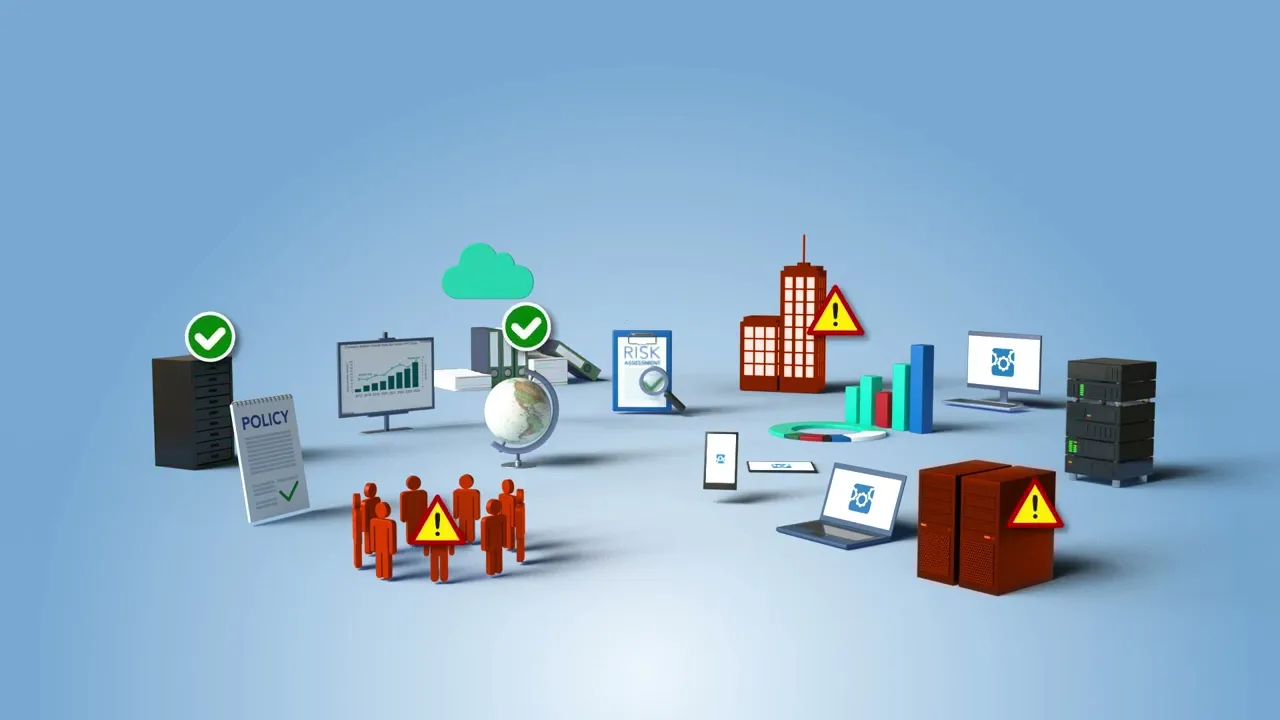Your Roadmap to Risk Reduction!
Table of Contents
ToggleThe Continuum GRC ITAM SaaS platform has hundreds of plugin modules available, such as:

Fedramp Solutions
The FedRAMP certification is the pinnacle for cloud service providers and provides the highest standard of certification assurances to your customers.
CSP Module Bundle includes:
- System Security Plan (SSP) High-Moderate-Low-Tailored
- System Security Plan (SSP)
- Plan of Action and Milestones (POA&M)
- Customer Responsibility Matrix
- Electronic Authentication (E-Authentication) Plan
- Privacy Impact Assessment (PIA)
- Rules of Behavior (RoB)
- Information System Contingency Plan (ISCP)
- CIS for SSP Low, Moderate, or High Baselines
- Federal Information Processing Standard (FIPS) 199 Categorization
- Integrated Inventory Workbook
- Information System Security Policies and Procedures
- Configuration Management (CM) Plan
- Control Implementation Summary (CIS)
- CIS Worksheet
- IT Contingency Plan (CP)
- Incident Response Plan (IRP)
- Rules of Behavior (ROB)
- AC Access Control
- AT Awareness and Training
- AU Audit and Accountability
- CA Certification, Accreditation, and Security Assessment
- CM Configuration Management
- CP Contingency Planning
- IA Identification and Authentication
- IR Incident Response
- MA Maintenance
- MP Media Protection
- PE Physical and Environmental Protection
- PL Planning
- PS Personnel Security
- RA Risk Assessment
- SA System and Services Acquisition
- SC System and Communications Protection
- SI System and Information Integrity
- PM Project Management
3PAO Module Bundle includes:
- Security Assessment Report (SAR)
- Security Assessment Plan (SAP)
- SAR Appendix A FedRAMP Risk Exposure Table (RET)
- SAR Appendix B Moderate Security Requirements Traceability Matrix
- Annual Assessment Controls Selection Worksheet
FedRAMP+ DoD IL
- FedRAMP+ System Security Plan Information Impact Level 2 (Non-Controlled Unclassified Information)
- FedRAMP+ System Security Plan Information Impact Level 4 (Controlled Unclassified Information)
- FedRAMP+ System Security Plan Information Impact Level 5 (Controlled Unclassified Information)
- FedRAMP+ System Security Plan Information Impact Level 6 (Controlled Unclassified Information)
ConMon
- Continuous Monitoring Activities & Deliverables: Continuous
- Continuous Monitoring Activities & Deliverables: Weekly
- Continuous Monitoring Activities & Deliverables: 10 days
- Continuous Monitoring Activities & Deliverables: Monthly
- Continuous Monitoring Activities & Deliverables: 60 days
- Continuous Monitoring Activities & Deliverables: Quarterly (90 days)
- Continuous Monitoring Activities & Deliverables: Annual
- Continuous Monitoring Activities & Deliverables: Every 2 years
- Continuous Monitoring Activities & Deliverables: Every 3 years
- Continuous Monitoring Activities & Deliverables: Every 5 years
- FedRAMP Significant Change Request Form
- FedRAMP Significant Change Request Form: Attachment A
Ensure Compliance in Cloud Environments
Any cloud service offerings must have the strictest protocols and controls. These days, data of all kinds is under assault; highly sensitive data, such as financial or that related to federal agencies, requires the highest of security controls. Fortunately, there are existing, established standards that address these evolving challenges. FedRAMP (Federal Risk and Management Program) provides a standardized approach to ensure that cloud service providers and third-party vendors meet specific security requirements to work with sensitive data.
With FedRAMP authorization, you can be assured that your organization has a handle on all the practices involved in the continuous monitoring of data in the cloud needed to reduce federal risk. Continuum GRC has the experience and expertise to do a thorough security assessment and uncover any particular federal risk. There are very specific standards that must be met to achieve FedRAMP authorization; we’ll help get your organization up to speed and stay there.
Purpose of FedRAMP
The FedRAMP program was created to provide a set of standardized security practices, guidelines, and goals for any cloud services involved with federal agencies. Achieving FedRAMP authorization means that your organization is meeting the most current security requirements and performing continuous monitoring to prevent the ever-evolving threats of cyberattacks.
FedRAMP provides companies with a single framework for assessing cloud services and one set of guidelines for making any adjustments. This single point of reference eliminates any questions or concerns about ensuring that a cloud service provider is in compliance with the rigorous security standards of the federal government.
Navigating your firm’s federal risk and other security issues can be challenging. Continuum GRC is the expert in every part of the FedRAMP process. We’ll guide you through the demanding security requirements that are necessary for working with any federal agency these days, and staying compliant.
Increase Efficiency in Obtaining FedRAMP Compliance
Achieving and maintaining compliance with the evolving security measures needed to work with a federal agency can be time-consuming and worrisome. What if you miss something? What happens to your valued FedRAMP authorization then?
Continuum GRC is the smart way to handle this complicated process. Compliance assessment and solutions are what we specialize in. The FedRAMP authorization process can be a long one; partnering with us to evaluate and monitor your practices and infrastructure takes some of the weight and time off employees. It ensures that you spot potential problems before they become an issue. We ensure that you are in line with the strict (and ever-evolving) federal demands around security.
Staying on top of those demands and standards on your own is risky and time-consuming; the security environment is constantly changing, with newer and greater threats. Handing off that great responsibility to Continuum GRC is a smart move.
What are you waiting for?
FAQ
What do FedRAMP compliance solutions typically include?
The point of the FedRAMP framework is to ensure optimal security for data. Compliance solutions include continuous monitoring of cloud systems, vulnerability scans, and risk assessments. Other actions may include better physical security and updated contingency plans for data breaches. Comprehensive logging and alert systems are also typically recommended.
Who needs FedRAMP ConMon solutions?
FedRAMP ConMon stands for “continuous monitoring.” It’s designed to maintain the security of cloud systems and prevent any unauthorized changes that could introduce potential risks. ConMon solutions are needed for any cloud service provider that wants to work with federal agencies. ConMon helps ensure ongoing compliance with security regulations.
Difference between FedRAMP compliance and ConMon?
FedRAMP compliance is a broad framework established by the government, providing a clear, standardized approach to security needs for cloud service providers that work for agencies.
ConMon (“continuous monitoring”) is one part of that framework, focused on ongoing assessments of the controls that ensure security compliance.
Can a CSP lose its FedRAMP authorization without proper ConMon practices?
Yes. ConMon practices are critical for ensuring that a strong security posture is being maintained at the CSP and that any incidents are noted. ConMon provides the evidence to federal agencies being serviced by that CSP by reporting on the security standards required to maintain FedRAMP authorization.
How often are continuous monitoring reports submitted?
For CSPs authorized under FedRAMP, a ConMon report must be submitted every month in order to maintain that authorization. These reports reveal ongoing compliance and include vital information like system changes, security incidents, and the results of regular vulnerability scans. Annual assessments are also conducted by third-party assessment organizations.
How long does it take to achieve FedRAMP compliance?
Typically, getting FedRAMP-certified takes from 12 to 18 months. This timeframe can be influenced by the preparation of the organization and its documentation. CSPs that are less complex (with fewer offerings) may have a faster go of it. Having a thorough risk and mitigation plan in place can also move things along.
You are just a conversation away from putting the power of Continuum GRC to work for you.
Contact us using the form below or calling us at 1-888-896-6207 for immediate assistance.
About this standard
The Federal Risk and Authorization Management Program (FedRAMP) is a U.S. government-wide program that provides a standardized approach to security assessment, authorization, and continuous monitoring for cloud products and services used by federal agencies. Below is a compliance overview of FedRAMP, covering its key components, requirements, and processes:
Purpose of FedRAMP
FedRAMP aims to:
- Ensure consistent security standards for cloud services used by federal agencies.
- Promote secure cloud adoption by reducing duplicative efforts, costs, and risks.
- Provide a framework for assessing, authorizing, and monitoring cloud service providers (CSPs).
Key Components of FedRAMP Compliance
- Standardized Security Requirements:
- FedRAMP is based on the NIST SP 800-53 security controls, tailored for cloud environments.
- CSPs must implement controls based on the system's security categorization (Low, Moderate, or High impact, as defined by FIPS 199).
- Low-impact systems have fewer controls, while High-impact systems require the most stringent measures.
- Authorization Process:
- Agency Authorization: A federal agency directly sponsors and assesses a CSP for an Authority to Operate (ATO).
- CSPs must work with a Third-Party Assessment Organization (3PAO) accredited by FedRAMP to conduct independent security assessments.
- Key Documentation:
- System Security Plan (SSP): Describes the CSP’s system, security controls, and implementation details.
- Security Assessment Plan (SAP): Outlines how the 3PAO will test the system’s security controls.
- Security Assessment Report (SAR): Documents the results of the security assessment, including vulnerabilities and risks.
- Plan of Action and Milestones (POA&M): Identifies weaknesses and outlines remediation plans with deadlines.
- Continuous Monitoring:
- After authorization, CSPs must maintain ongoing compliance through continuous monitoring.
- This includes regular vulnerability scans, annual assessments, and reporting significant changes or incidents to the authorizing agency or JAB.
- CSPs submit monthly reports to demonstrate compliance with FedRAMP requirements.
- FedRAMP Marketplace:
- The FedRAMP Marketplace (fedramp.gov) lists authorized cloud services, including those with an ATO or P-ATO, to help agencies identify compliant providers.
- It also provides details on 3PAOs and other FedRAMP resources.
Compliance Levels
- Low Impact: For systems with limited adverse effects if compromised (e.g., public-facing websites). Requires fewer controls (~125).
- Moderate Impact: For systems with serious adverse effects if compromised (e.g., sensitive but unclassified data). Requires more controls (~325).
- High Impact: For systems where compromise could cause severe or catastrophic effects (e.g., critical infrastructure or classified data). Requires the most controls (~400+).
- FedRAMP High+: Some agencies, like the DoD, may impose additional controls for specific high-impact systems.
Key Stakeholders
- FedRAMP Program Management Office (PMO): Administered by the GSA, the PMO oversees the program, accredits 3PAOs, and maintains standards.
- Cloud Service Providers (CSPs): Companies offering cloud services (IaaS, PaaS, SaaS) seeking FedRAMP authorization.
- Third-Party Assessment Organizations (3PAOs): Independent entities that assess CSP security controls.
- Federal Agencies: Use FedRAMP-authorized services and may sponsor CSPs for authorization.
FedRAMP Process
- Preparation:
- CSPs select a security baseline (Low, Moderate, or High) based on their system’s data sensitivity.
- They develop an SSP and prepare for assessment by a 3PAO.
- Assessment:
- The 3PAO conducts an independent assessment, testing controls, and documenting findings in the SAR.
- Authorization:
- The agency reviews the assessment package (SSP, SAP, SAR, POA&M) and grants an ATO or P-ATO.
- Continuous Monitoring:
- CSPs maintain compliance through ongoing monitoring, reporting, and remediation of vulnerabilities.
Benefits of FedRAMP Compliance
- Reusability: An ATO or P-ATO can be leveraged by multiple agencies, reducing redundant assessments.
- Cost Efficiency: Standardized processes lower the cost of compliance for CSPs and agencies.
- Security Assurance: Rigorous assessments ensure robust protection of federal data.
- Market Access: FedRAMP authorization allows CSPs to compete for federal contracts.
Challenges
- Time-Intensive: Achieving authorization can take 6–18 months, depending on the system’s complexity.
- Costly: Assessments, 3PAO fees, and ongoing monitoring require significant investment.
- Evolving Requirements: CSPs must stay updated on changing NIST standards and FedRAMP policies.
Recent Updates (as of August 2025)
- FedRAMP Modernization: The program is transitioning to FedRAMP Rev. 5, aligning with NIST SP 800-53 Revision 5, which emphasizes automation, supply chain risk management, and privacy controls.
- Automation Initiatives: FedRAMP encourages the use of Open Security Controls Assessment Language (OSCAL) to streamline documentation and assessments.
- Cloud Service Models: Supports Infrastructure as a Service (IaaS), Platform as a Service (PaaS), and Software as a Service (SaaS).
- StateRAMP Alignment: FedRAMP collaborates with StateRAMP to extend similar security standards to state and local governments.
How to Get Started
- CSPs should review the FedRAMP Authorization Playbooks on fedramp.gov.
- Engage a 3PAO from the FedRAMP Marketplace for assessment.
Amazing Benefits

